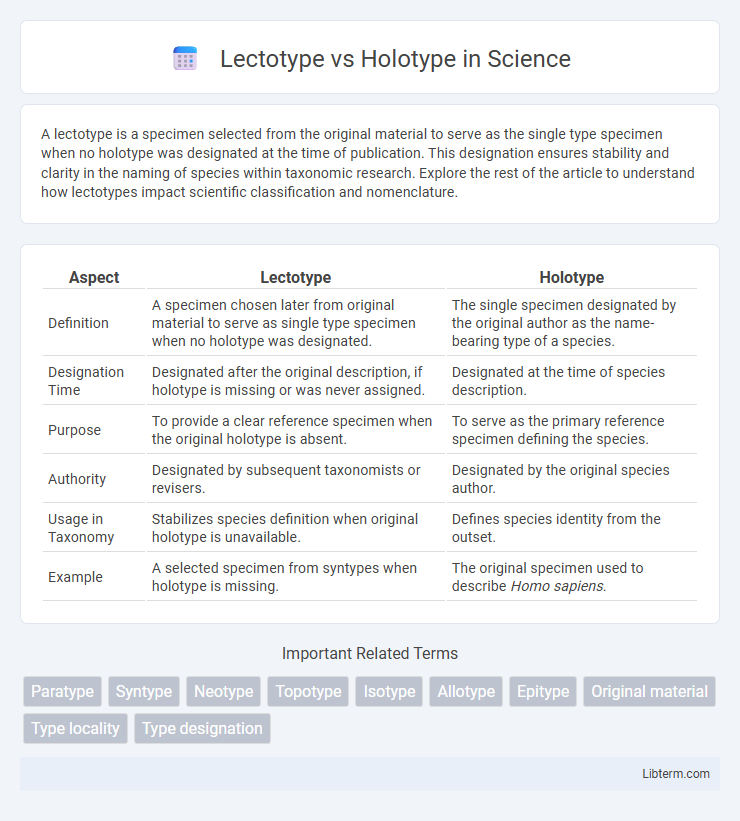A lectotype is a specimen selected from the original material to serve as the single type specimen when no holotype was designated at the time of publication. This designation ensures stability and clarity in the naming of species within taxonomic research. Explore the rest of the article to understand how lectotypes impact scientific classification and nomenclature.
Table of Comparison
| Aspect | Lectotype | Holotype |
|---|---|---|
| Definition | A specimen chosen later from original material to serve as single type specimen when no holotype was designated. | The single specimen designated by the original author as the name-bearing type of a species. |
| Designation Time | Designated after the original description, if holotype is missing or was never assigned. | Designated at the time of species description. |
| Purpose | To provide a clear reference specimen when the original holotype is absent. | To serve as the primary reference specimen defining the species. |
| Authority | Designated by subsequent taxonomists or revisers. | Designated by the original species author. |
| Usage in Taxonomy | Stabilizes species definition when original holotype is unavailable. | Defines species identity from the outset. |
| Example | A selected specimen from syntypes when holotype is missing. | The original specimen used to describe Homo sapiens. |
Introduction to Specimen Types in Taxonomy
Holotype refers to the single physical specimen designated by the original describer as the name-bearing type of a species, serving as the primary reference point for identification and classification. Lectotype is a specimen later selected from the original material when no holotype was designated or is lost, serving to stabilize nomenclature and clarify species concepts. Both specimen types are crucial in taxonomy to ensure accurate species delimitation and consistent use of scientific names in biodiversity studies.
Defining Holotype: The Primary Reference Specimen
A holotype is the single physical specimen designated by the original author to serve as the definitive example of a species, ensuring consistent identification and classification in taxonomy. It functions as the primary reference point for comparing other specimens and resolving taxonomic ambiguities. In contrast, a lectotype is a specimen later selected from existing material when no holotype was originally designated or when the holotype is lost or destroyed.
What is a Lectotype? An Overview
A lectotype is a specimen selected from the original material to serve as the single type specimen when the holotype was not designated at the time of publication or is lost. It acts as the definitive reference point for the species' identity, stabilizing its nomenclature under the International Code of Zoological Nomenclature (ICZN). Lectotypes are crucial for resolving taxonomic ambiguities and ensuring consistent species identification in biological research.
Historical Reasons for Designating a Lectotype
The designation of a lectotype historically arises when the original holotype was not specified by the author or has been lost or destroyed, ensuring taxonomic stability by providing a single reference specimen. Early botanical and zoological descriptions frequently lacked explicit holotypes, leading to ambiguity in species identification that lectotype selection resolves. This practice preserves nomenclatural consistency by anchoring the species name to one definitive specimen after the original publication.
Process of Lectotype Selection
The process of lectotype selection occurs when the original holotype is lost, destroyed, or was never designated during species description, requiring taxonomists to choose a single specimen from the available syntypes to serve as the species' name-bearing type. This selection must comply with the International Code of Nomenclature rules to ensure stability and clarity in species identification. Lectotype designation clarifies taxonomic ambiguities, reinforcing consistent application of species names in scientific classification.
Holotype vs Lectotype: Key Differences
Holotype refers to the single specimen designated by the original author at the time of species description, serving as the definitive reference for that species. Lectotype is a specimen later selected from the original material when no holotype was designated or the holotype has been lost or destroyed. The key difference lies in timing and designation authority: holotypes are chosen initially and explicitly, whereas lectotypes are selected retroactively to stabilize nomenclature.
Importance of Type Specimens in Biological Classification
Type specimens, including lectotypes and holotypes, serve as definitive reference points in biological classification, ensuring consistent species identification and nomenclature. A holotype is the single specimen designated by the original author to represent a species, whereas a lectotype is selected later from original material if no holotype was assigned, clarifying taxonomic ambiguity. These specimens anchor species names to physical examples, facilitating accurate communication and research across taxonomy, biodiversity studies, and conservation efforts.
Common Issues with Holotypes and Lectotypes
Holotypes often suffer from damage, incomplete specimens, or loss, complicating taxonomic clarity and species identification. Lectotypes are designated to resolve ambiguities when holotypes are missing or inadequate, ensuring stable nomenclature by providing a definitive reference specimen selected from original material. Common issues include mislabeling, unclear provenance, and inconsistencies in specimen preservation, which both holotypes and lectotypes may exhibit, hindering accurate scientific communication.
Case Studies: Lectotype Designation in Practice
Case studies of lectotype designation illustrate its critical role in stabilizing taxonomic names when original holotypes are lost or inadequately described. For example, in botanical nomenclature, lectotypes are often selected from original material such as herbarium specimens to clarify species identity, as seen in the reassessment of several historical plant names. These cases demonstrate how lectotype designation ensures nomenclatural consistency and supports accurate species delimitation in taxonomic revisions.
Conclusion: The Role of Holotype and Lectotype in Taxonomy
Holotypes serve as the primary reference specimen upon which the description and name of a new species are based, ensuring stability and consistency in taxonomy. Lectotypes are designated from existing specimens when no holotype was originally assigned, providing a clear standard for species identification and resolving taxonomic ambiguities. Both holotypes and lectotypes are crucial for maintaining accurate species classification and supporting effective communication within the scientific community.
Lectotype Infographic

 libterm.com
libterm.com